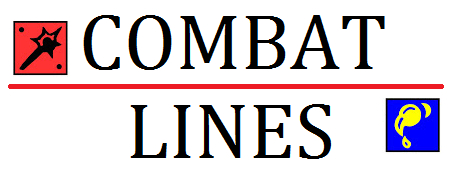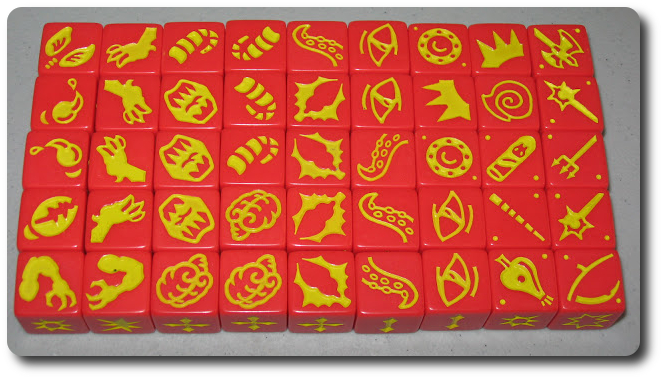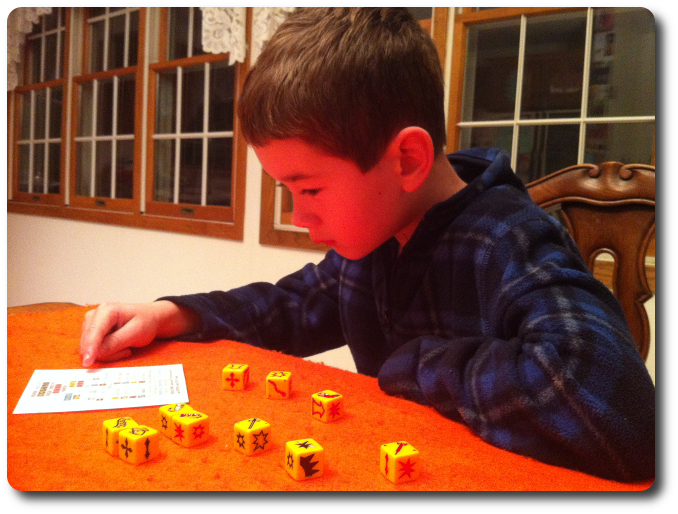
The Basics:
- For ages 8 and up (publisher suggests 10+)
- For 2 players
- Approximately 45 minutes to complete
Geek Skills:
- Counting & Math
- Logical & Critical Decision Making
- Reading
- Pattern Matching
- Risk vs. Reward
- Hand/Resource Management
- Bidding
Learning Curve:
- Child – Moderate
- Adult – Easy
Theme & Narrative:
- Muster your army and organize them into attack waves using dice to build combat lines of destruction!
Endorsements:
- Gamer Geek rejected!
- Parent Geek rejected!
- Child Geek rejected!
Overview
Standing above the battlefield, you survey your troops. On the horizon, you can just make out the enemy camps. Between your army and your opponent is a green valley that will soon be host to a bloody battle. You will lose warriors, but with cunning, you should be able to outthink your opponent and achieve victory. You only hope that luck is with you as you lead your army to meet your destiny.
Combat Lines, by Terran Games, is comprised of 45 yellow custom six-sided dice, 45 black custom six-sided dice, 10 white custom six-sided dice, and 2 small laminated player aid sheets (double-sided). The game also comes with 2 hand-sewn cloth dice bags to help keep all the dice in one place while playing. Note that your game can come with blue and red dice, instead of black and yellow. The dice are imprinted with different symbols that represent five different classes. These classes are weapons, shields, warriors, actions, and special actions. If you are familiar with . Not included in the game, but necessary to play, is some sort of divider or player screen.

Example of the dice used in the game – Players familiar with Chaos Progenitus will recognize the icons
Game Set Up
To set up the game, have each player take all 45 dice of the same color (blue, red, yellow, or black). There should be 45 in total and there is no difference in the dice other than the colors. Players should sit so there is a common playing area between them and enough space to roll dice. If you have a dice tray, use it. There are a lot of dice in this game.
Second, each player takes and places all 45 of their dice in one of the cloth dice bags. This bag is theirs for the duration of the game and will allow the players to draw from a their own dice pool randomly. The contents of the cloth dice bag are referred to as the player’s “Starting Pool”.
Third, the 10 white custom six-sided dice are set to one side and within easy reach of all players. These are referred to as “Common Dice”.
Fourth, give to each player a player aid sheet.
You are now ready to begin! Determine who will be the first player and get ready to rumble.
This Is How I Combat Roll
The game is played and completed in 3 rounds with each round including two phases that are repeated 4 times per round. Each phase is further broken down into specific actions that are completed by both players. Each phase is summarized here.
Phase 1: Preparation
During this phase, the players will be draw dice, bid for initiative, create dice pools from the remaining dice available, and create their combat lines.
The first player will blindly draw 10 dice from their cloth dice bag. All of these dice are rolled and then separated by class. Note that once dice are rolled, they can never be re-rolled. The first player forms three groups using the rolled dice. One group will be comprised of nothing but “1 Hit”, the second will be comprised of “1 Initiative”, and any remaining dice are grouped together to form the player’s “Force Pool”.
Once separated into three different groups, the first player now decides if they want to combine the “1 Hit” or the “1 Initiative” groups with the “Force Pool”. Not both. Essentially, the player is deciding if they want to be faster or hit harder. Whichever group is not selected is placed aside and creates the player’s “Used Pool”.
This step is repeated by the first player two more times by selecting another 10 dice, rolling them, separating them, and then combining them. When completed, the player will have two different pools. The “Force Pool” and the “Used Pool”.
The second player now repeats the above, rolling dice, and creating their own “Force” and “Used” pools.
Once both players have their pools, they bid for initiative. The second player starts this by placing at least 1 initiative die from their “Force Pool” in front of them. The first player now either selects and places more initiative dice from their “Force Pool” or passes. This continues, back and forth, until one player passes and the other player wins the bid. All dice used in the bid are returned to the player’s “Starting Pool”.
The winner of the initiative now collects the 10 white Common Dice and rolls them. From the rolled results, 3 are taken and placed in the player’s “Force Pool”. From the remaining 7 Common Dice, 2 are selected and given to the opponent to be played in their “Force Pool”. The remaining 5 unclaimed Common Dice are set aside and become the “Common Dice Pool” that can be drawn from during the round.
Using a divider or player screen, players now create 4 combat lines using their “Force Pool”. Here’s hoping that each player somewhat kept track of what their opponent rolled. Each combat line must contain at least 4 dice, but no more than 10. The one exception is if a player has less than 16 non-special dice in their “Force Pool” after the initiative bid. In which case, one line can contain only 1 die. The rolled values cannot be altered.
Each line can contain any combination of classes, but each class provides a special effect and uses the dice that follow it. They are summarized here.
- Weapons: this class uses the hits that follow it as damage
- Shields: this class uses the hits that follow it to cancel damage
- Warriors: this class represents four different strengths of warriors from the very weak (takes 1 hit to kill them) to the very strong (takes 4 hits).
- Hits and Initiatives: these two classes work together. For every hit that is not attached to a weapon, it must be paired with an initiative.
- Specials: this class allows the player to manipulate the combat lines, but only when they are “engaged”. Manipulated dice can be in the player’s combat line or their opponent’s.
Once the combat lines are created, the dividers or player screens are removed, and combat is resolved.
Phase 2: Combat Resolution
During this phase, the combat lines are revealed and resolved, starting with the player who won the initiative who is referred to as the “Attacker”.
Combat resolution is completed using sequential steps which are summarized here.
First, the Attacker chooses which combat line that belongs to their opponent they want to engage using one of their own combat lines.
Second, if any of the dice are special in either of the engaged combat lines, they can now be used to manipulate the lines and some dice can be re-rolled.
Third, and once all changes are done to the combat lines, the player’s count the hits. Dice hits are either blocked or result in a die being sidelined (removed).
Fourth, once all combat is concluded, a winner is declared and the winner collects 1 die from their opponent’s combat line. This die is now captured and counted as a victory. The player who wins it during combat should set it aside and out of play. Any remaining dice in the used combat lines are placed in the “Used Pool”.
Now initiative is passed to the other player who becomes the Attacker and repeats the same steps by selecting a combat line to engage and resolve. Once that combat line is resolved, the initiative is passed back to the other player. In this way, both players will be the Attacker and the Defender.
Ending Combat
The combat ends once all four of the combat lines have been engaged and resolved. All the Common Dice are returned to a single pool and all non-captured dice are returned to each player’s Starting Pool. A new round now begins starting with the first phase as noted above.
Ending the Game
The game ends after the fourth and final combat line is resolved on the third round of play. The player who has the most captured dice is declared the winner.
To learn more about Combat Dice, visit the game’s web page. Images of the rule book can be viewed on Board Game Geek.
Prediction
Lots of dice in this game and most dice games appeal to the Child Geeks. Heck, they appeal to the Parent and Gamer Geeks, too! There’s just something about rolling dice that feels good. There is always a level of excitement in the game because anything can happen with a single roll. Of course, this also means a high level of randomness that gets old with the Gamer Geek crowd. But this game is more than just rolling dice. The players need to use what is rolled as a resource that they must then assign, building what they hope to be an unstoppable combat line. This means the game does requires some critical thought from the players and heavy dice management.
Teaching this game is a real chore. The game itself is not difficult, but the many different dice faces and what they mean is a lot to absorb. In total, there are over 20 icons to learn that each represent a special class and an associated action. The player aid sheet is an absolute must in this game, otherwise there is no way for a player to understand what they are looking at. The majority of the icons used on the dice are meaningless, or better put, do not allow the mind to easily associate what is on the die to a specific class or action. For example, the icon of an eye and a tentacle represents a warrior. Additionally, some of the icons are not even recognizable as anything, making it even more difficult to determine what it is you actually rolled.
And so, as I set up the game to play with my oldest little geek, I asked him his thoughts on Combat Lines so far. I didn’t bother to teach this game to my 5-year-old, because the game requires the player to be able to read and understand the player aid sheet. While a younger player will be able to play as a team member, I don’t consider this game “playable” by anyone who cannot read.
“I like all the dice, but I’m having a hard time knowing what any of them mean. I think I’ll be spending a lot of time with the player sheet.” ~ Liam (age 8)
Yeah, me, too.
Final Word
Combat Lines flopped with the Child Geeks. They never felt comfortable enough with it to enjoy the game. The majority of time was spent just trying to figure out what each of the dice meant. Then, when they formed their combat lines, they were rather put out when they misinterpreted the dice. Bad dice in a bad combat line means epic failure, most of the time. The game also took way too long with the Child Geeks. A typical game should only take you about 30 to 45 minutes. With some of the Child Geeks, a game lasted over an hour because they spent so much time reviewing each of their dice. Some games didn’t even make it to the second round because the Child Geeks just felt worn out. In the end, the Child Geeks didn’t find the game fun, but really liked the dice.

My little geek reviews his dice using the player aid sheet
The Parent Geeks didn’t care for this game either. They found the icons just as confusing, but were able to work with them. Their combat lines were much stronger and better constructed, and a typical game was completed in less than 1 hour. Their first impression of the game was one of optimistic excitement. They have played games like Quarriors, Zombie Dice, and Martian Dice before with their Child Geeks and everyone had a great time. They thought Combat Lines would be a great game, too, but after a few games, they decided it wasn’t. While the Parent Geeks appreciated what the game was about, how the dice were used as resources, and the high level of critical thought that had to go into it to play the game well, they didn’t appreciate how the game went about it. According to one Parent Geek, “This games requires way too much of my time just figuring out what the game is trying to tell me.”
Gamer Geeks were able to grasp and play the game fairly easily. A typical game with a Gamer Geek lasted only about 30 or so minutes and always ended with one player being declared the victor. But the game did little to impress the Gamer Geeks. While they also thought the game did a good job of requiring the player to do a lot of critical thinking and use their dice as a resource to build their combat lines, they didn’t think the game did it well enough to make it fun. “Feels a little bit like work that doesn’t pay well”, said one Gamer Geek. In the end, the Gamer Geeks didn’t approve it because the game required way too much of their time with their eyes reading the player’s aid sheet and less on the goal of victory.
This game starts out strong but limps across the finish line, struggling under its own weight. The game is very ambitious and I like much of what it is trying to do. Unfortunately, I don’t think it executes smoothly enough to be a game that is much fun to play. I spent way too much time trying to figure out what it was I had rolled and not enough time enjoying the game. After playing Combat Lines several times, I was still heavily dependent on the player aid sheet, making it an absolute necessity to play and a burden. From a Gamer and Parent Geek perspective, it failed to thrill or keep me interested, despite its attempts to be fast-paced and evoke feelings of exciting combat.
This game was given to Father Geek as a review copy. Father Geek was not paid, bribed, wined, dined, or threatened in vain hopes of influencing this review. Such is the statuesque and legendary integrity of Father Geek.



